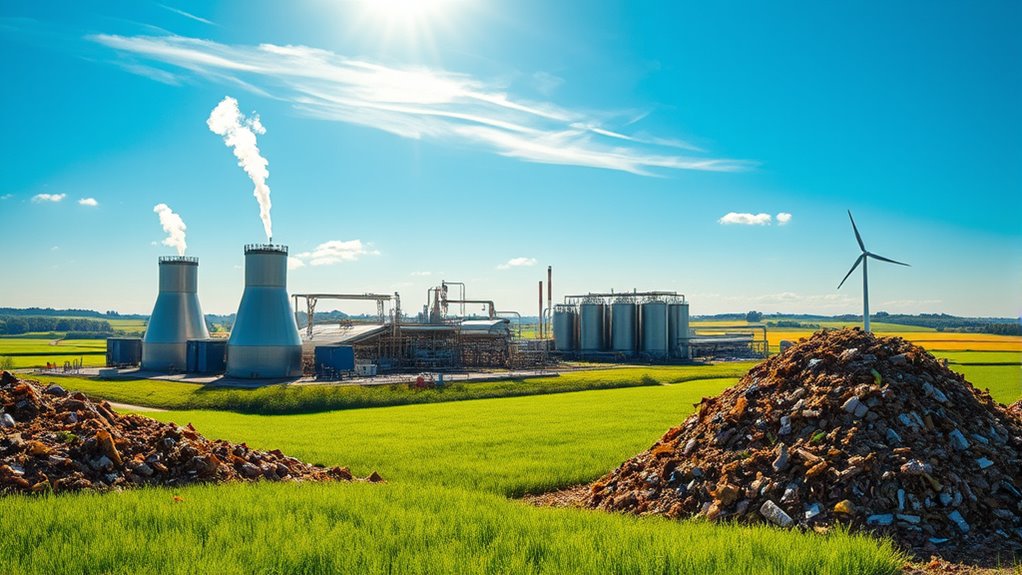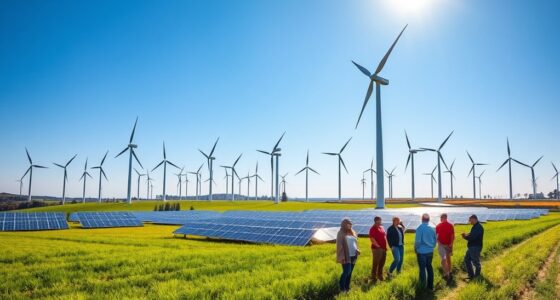Bioenergy turns waste into power by converting organic materials, like food scraps and agricultural residues, into renewable energy. Through methods like anaerobic digestion and gasification, you can transform municipal solid waste into usable electricity and heat. This process not only reduces the amount of waste in landfills but also helps achieve carbon neutrality by balancing carbon emissions. Interested in how this innovative approach is shaping the future of energy? There’s more to explore on the topic.
Key Takeaways
- Waste-to-energy (WtE) systems convert municipal solid waste into electricity or heat, significantly reducing landfill volumes.
- Common WtE methods include incineration, gasification, and anaerobic digestion for energy recovery from organic waste.
- Biomass energy is considered carbon-neutral, as CO2 released during combustion equals what plants absorb during growth.
- Modern WtE technologies minimize pollutants and promote sustainability through efficient resource management and energy recovery.
- Innovations in biogas production from organic waste provide clean energy solutions, enhancing the viability of bioenergy systems.
Understanding Biomass and Its Sources

Biomass, an indispensable component of our energy landscape, comes from organic materials derived from plants and animals. It includes wood, agricultural residues, and various organic waste, all essential for energy production. You’ll find that biomass is utilized commercially for fuel and fiber, playing a significant role in ecosystem productivity and nutrient flows. Key sources of biomass include traditional wood for combustion, agricultural crops like corn for biofuels, and waste materials such as food scraps. Wood is a traditional biomass source that has been used for heating and power generation for centuries. Additionally, solar energy can enhance biomass production by improving crop yields through efficient irrigation systems. Recent advancements in hydrogen fuel cells have opened new avenues for integrating biomass with renewable energy sources. Algae serve as a rapidly growing option for biofuels, while animal manure can produce biogas through anaerobic digestion. Understanding these sources helps you appreciate biomass’s potential and its importance in creating sustainable energy solutions. Natural remedies can also contribute to reducing waste, as they provide alternatives for energy generation that are derived from organic materials.
The Carbon-Neutral Advantage of Biomass
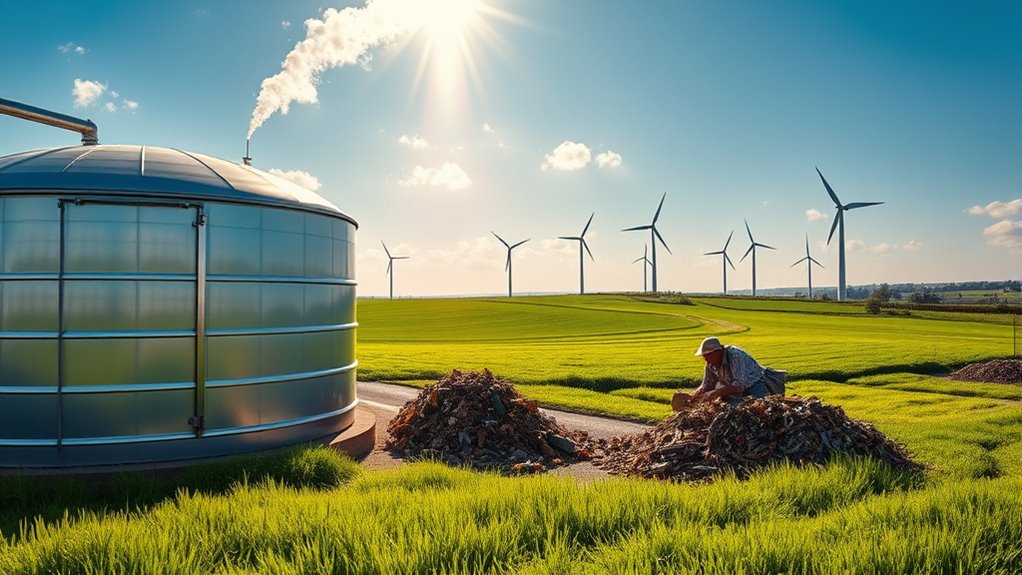
While many energy sources contribute to carbon emissions, biomass stands out for its potential to achieve carbon neutrality. When you burn biomass, the carbon dioxide released is part of the natural carbon cycle, balanced by the carbon absorbed during the plant’s growth.
Unlike fossil fuels, biomass doesn’t emit “new” carbon into the atmosphere. For it to remain carbon neutral, verify it’s grown sustainably and that minimal energy is used for processing. Additionally, biomass technology typically requires lower capital investment compared to fossil fuel infrastructure, making it an attractive option for energy producers. Furthermore, biomass can be integrated with renewable energy sources to enhance energy efficiency and sustainability. Heat pumps can also play a role in improving overall system efficiency when used alongside biomass energy solutions. With advancements in renewable energy technologies, biomass can further increase efficiency and contribute to a more sustainable energy landscape.
Biomass offers a carbon-neutral alternative to fossil fuels when sustainably sourced and minimally processed.
By replacing fossil fuels, biomass not only reduces net greenhouse gas emissions but also helps manage waste, converting organic materials that would otherwise end up in landfills.
This renewable resource diversifies your energy mix, ultimately contributing to a cleaner environment and a more sustainable future.
Conversion Technologies for Biomass Energy

Harnessing the carbon-neutral potential of biomass requires effective conversion technologies to transform organic materials into usable energy.
You can choose from various methods, such as thermochemical processes like combustion, pyrolysis, and gasification, which utilize heat and chemical reactions to generate electricity and fuels. Energy-efficient models can significantly enhance the efficiency of these conversion processes. Additionally, heat pumps can be integrated with biomass systems to further increase overall energy efficiency in heating and cooling.
Biochemical conversion, involving fermentation and anaerobic digestion, allows for biofuel production through microbial action.
Additionally, physicochemical methods, including torrefaction and supercritical fluid extraction, enhance biomass properties and yield valuable products. Thermochemical conversion processes play a crucial role in maximizing energy output from biomass sources. Each of these technologies supports sustainable energy systems while reducing greenhouse gas emissions by utilizing carbon captured during biomass growth.
Biofuel Production: Pathways and Processes
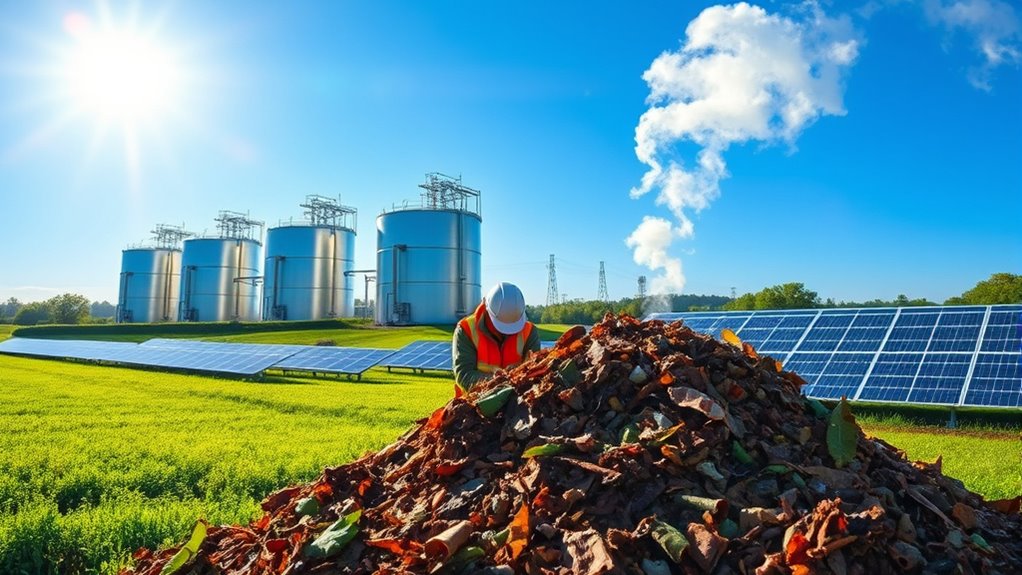
Biofuel production involves diverse pathways and processes that transform organic materials into usable energy sources.
You can find several types of biofuels, like ethanol, derived mainly from corn starch, and biodiesel, made from vegetable oils and animal fats through transesterification. Additionally, wood stoves serve as an eco-friendly option, providing a renewable energy source when properly managed and utilized. Proper installation techniques, such as venting requirements, ensure the safe and efficient operation of wood stoves. Many outdoor enthusiasts rely on portable camping toilets to maintain cleanliness while using renewable energy sources at their campsites.
Advanced biofuels such as cellulosic ethanol utilize waste biomass, while butanol, produced via fermentation, offers higher energy density than ethanol. Additionally, waste-to-energy technology significantly contributes to the production of biofuels by converting organic waste into valuable energy resources.
Renewable diesel comes from various feedstocks, including waste oils, using hydrotreating processes.
Key production methods include fermentation for ethanol, transesterification for biodiesel, and gasification for syngas conversion. As you explore these processes, you’ll see how innovations are addressing challenges in cost, efficiency, and sustainability, ultimately paving the way for a greener energy future.
Waste-to-Energy Systems Explained
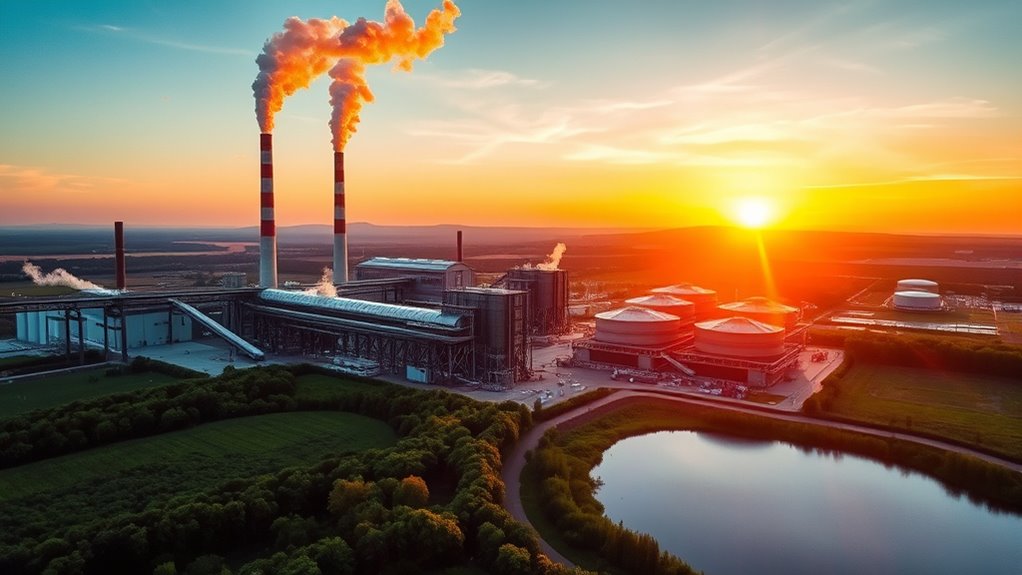
Waste-to-energy (WtE) systems provide an efficient solution for managing waste while generating valuable energy. By converting municipal solid waste, including paper, plastics, and organic materials, into usable energy forms like electricity or heat, WtE plays an essential role in modern waste management. Common methods include incineration, which burns waste to produce steam for turbines, gasification, which creates syngas without combustion, and anaerobic digestion, a biological process that generates biogas. These technologies not only reduce waste volume considerably—often by about 87%—but also contribute to energy production. As you explore WtE systems, you’ll see how they integrate waste management and energy generation, paving the way for a more sustainable future. Direct combustion is the most widely employed method for energy recovery, effectively reducing waste volume by 95-96% and recovering valuable materials like metals. Additionally, the principles of long-term financial planning can help communities invest in and sustain these innovative energy solutions. Moreover, effective location scouting can enhance the selection of optimal sites for WtE facilities, ensuring better integration with existing infrastructure and community needs. Furthermore, WtE systems align with circular economy practices by promoting the reuse of resources while generating energy.
Environmental Benefits of Biomass Energy

While many energy sources contribute to environmental degradation, biomass energy stands out for its numerous ecological advantages.
It’s a renewable energy source derived from plants and organic materials, ensuring a sustainable alternative to fossil fuels. By tapping into agricultural, forestry, and waste management sectors, you can considerably reduce reliance on finite resources. Biomass is recognized as one of the best energy sources for economic and environmental benefits, supporting rural development and local economies. Additionally, using wood pellet fuel can enhance the efficiency of biomass energy systems, making them more effective. Diverse forage from agricultural practices also contributes to the sustainability of biomass energy. Moreover, the rise in angel investments in green technologies enhances the potential for innovation in biomass energy solutions.
Biomass is considered carbon-neutral since the CO2 released during combustion equals what plants absorb during growth, helping mitigate the greenhouse effect. Additionally, using organic waste for energy lessens landfill contributions and supports cleaner environments.
Biomass energy is carbon-neutral, reducing landfill waste and promoting a cleaner, healthier environment.
With modern technologies minimizing pollutants, biomass energy not only decreases greenhouse gas emissions but also promotes biodiversity through sustainable management practices.
Embracing biomass energy can lead to a healthier planet for everyone.
Commercial Developments in Bioenergy

As the demand for renewable energy continues to rise, commercial developments in bioenergy are rapidly evolving to meet this need.
You’ll notice an increasing interest in biomass, driven by its role in bioenergy and carbon credit markets. Innovative sources like landscaping waste and municipal solid waste are being explored, expanding biomass production beyond traditional regions. The carbon credit market is significantly fueling biomass supply needs, further emphasizing its importance in the bioenergy sector. Additionally, the integration of diverse bioenergy products can lead to enhanced marketability and reduced waste. Implementing strategies for managing behavioral issues in communities can also support the acceptance and adoption of bioenergy initiatives. Furthermore, the demand for sustainable practices in industries, such as the tea industry, is influencing biomass utilization and encouraging responsible sourcing.
Technologies such as anaerobic digestion and gasification are advancing, enhancing efficiency in bioenergy conversion. Additionally, integrated biorefineries are becoming essential for producing diverse bioenergy products.
Policy support, like the Inflation Reduction Act, is also propelling growth. With a focus on sustainability and cost reductions, the bioenergy industry is positioning itself as a critical player in the renewable energy landscape.
Overcoming Challenges in Biomass Utilization
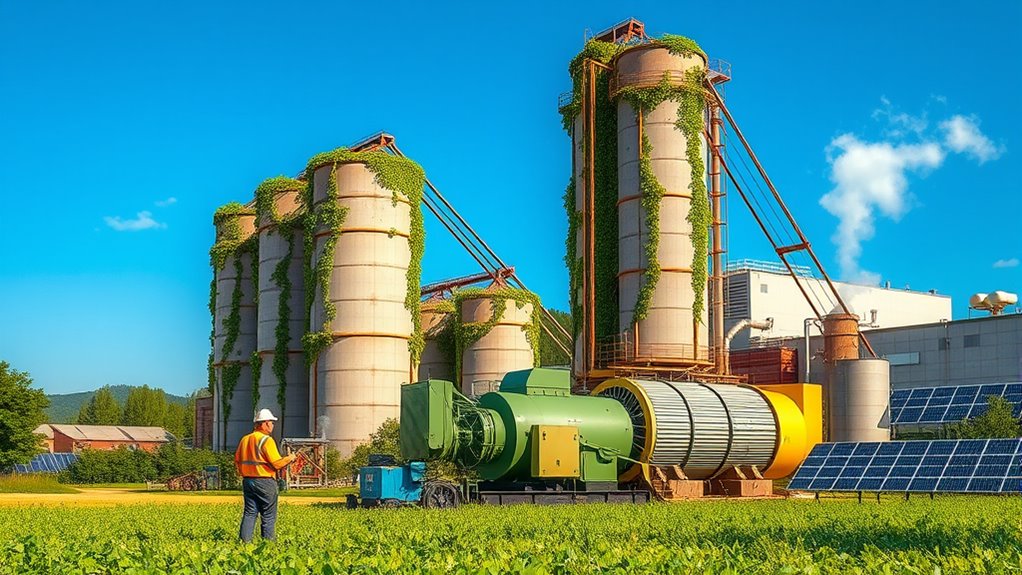
How can we effectively address the challenges of biomass utilization?
First, securing reliable feedstock is essential. You could collaborate with local farmers and establish long-term contracts to reduce variability and costs. Enhancing transportation efficiency by investing in better logistics can also lower expenses. Additionally, addressing feedstock unavailability through better resource management will contribute to a more stable supply chain.
Next, focus on improving conversion technologies to boost energy efficiency and product quality. Supporting research and development can help overcome technical barriers and make biomass more competitive.
Improving conversion technologies is crucial for enhancing energy efficiency and product quality in biomass utilization.
Finally, engage stakeholders in open communication to balance economic, environmental, and social impacts. Addressing land use issues and promoting sustainable practices will foster community support and create new job opportunities.
The Role of Policy and Infrastructure
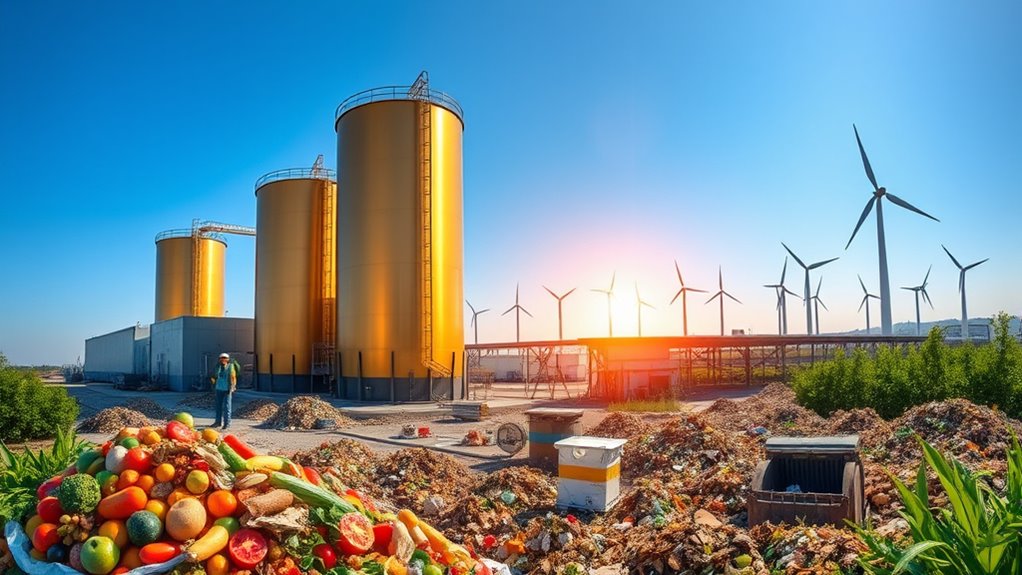
To effectively harness the potential of bioenergy, a robust policy framework and supportive infrastructure are essential. You need clear targets and strategies to guide development and financial incentives like subsidies to attract investment. Establishing stable regulatory frameworks boosts investor confidence and facilitates trade. Modern bioenergy’s contribution to energy and feedstocks guarantees bioenergy aligns with environmental goals while raising public awareness fosters stakeholder support. On the infrastructure side, developing biorefineries and improving biomass supply chains enhance production efficiency. Energy storage solutions guarantee a reliable supply, while integrating biomethane into natural gas grids broadens market access. Utilizing district heating networks in urban areas can optimize biomass-based heating.
Future Prospects for Bioenergy Innovations
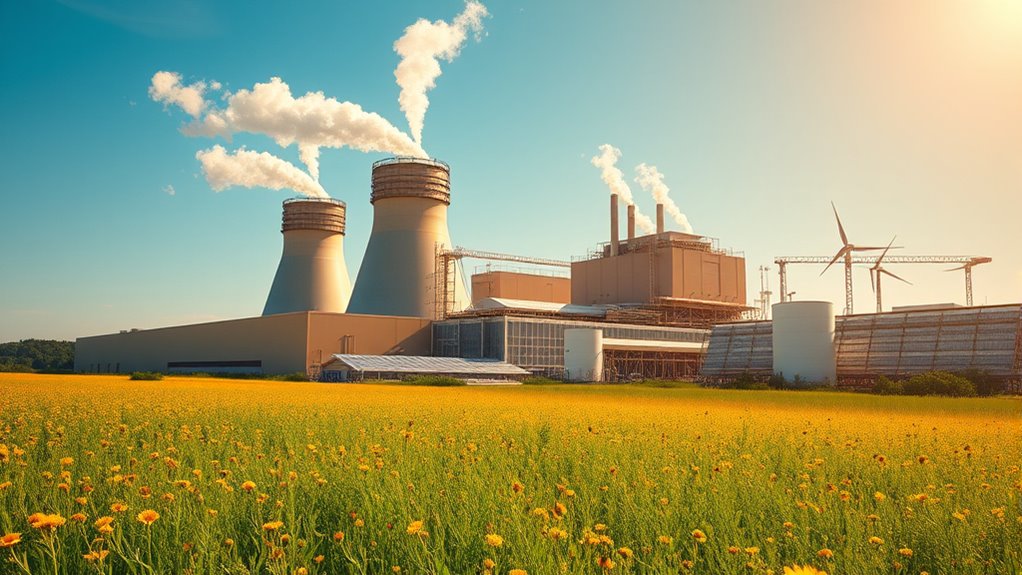
While the future of bioenergy holds immense promise, innovations in technology and processes will be crucial for unblocking its full potential. Advanced biofuels from non-food sources, like agricultural waste and algae, can replace fossil fuels sustainably. Combining bioenergy with carbon capture and storage (BECCS) offers a significant solution for climate change, removing CO2 from the atmosphere. You’ll see synthetic biology enhance biofuel production efficiency, while biogas innovations transform organic waste into clean energy. Emerging technologies like waste-to-energy technologies, including gasification and anaerobic digestion, will help manage waste and generate power. As bioenergy demand grows, overcoming technological challenges will be essential for maximizing its benefits for transportation, industry, and electricity generation, making it a cornerstone of a sustainable future.
Frequently Asked Questions
How Does Biomass Energy Compare to Fossil Fuels in Efficiency?
When you compare biomass energy to fossil fuels in efficiency, you’ll find that biomass generally has lower energy density.
Direct combustion isn’t as efficient as advanced methods like gasification. However, biomass can replace fossil fuels in various applications, particularly when you consider emissions credits.
Co-firing biomass with fossil fuels can enhance overall efficiency, allowing you to utilize existing infrastructure effectively.
Despite this, biomass technologies are continually improving, making them increasingly competitive.
What Are the Economic Costs of Biomass Energy Production?
When you consider the economic costs of biomass energy production, you notice significant capital and operating expenses.
Capital costs range from $1,880 to $6,100 per kW, depending on the technology. Operating and maintenance costs typically account for 9% to 20% of the levelized cost of electricity.
Feedstock costs also vary, from $10 to $160 per ton, impacting overall viability. These factors make financial planning essential for successful biomass energy projects.
Is Biomass Energy Suitable for All Geographical Locations?
Biomass energy isn’t suitable for all geographical locations. It thrives where land is available, resources are abundant, and climate conditions support growth.
You’ll find that densely populated areas struggle with land constraints, while remote regions may lack the necessary infrastructure.
Additionally, local policies can either boost or hinder biomass development. Understanding these factors can help you assess whether biomass energy fits your specific geographical context and resource availability.
What Safety Measures Are in Place for Biomass Plants?
In biomass plants, you’ll find several essential safety measures in place. You must conduct thorough risk assessments to identify hazards and implement control measures.
Facilities are designed with safety in mind, featuring rounded edges and sealed machinery. Regular training for staff guarantees everyone knows procedures, while compliance audits confirm adherence to regulations.
Additionally, ventilation and dust collection systems help prevent dust-related incidents, keeping your work environment safe and compliant.
How Is Biomass Energy Regulated at the National Level?
Regulating biomass energy at the national level is like steering through a complex maze.
You’ve got the Renewable Fuel Standard (RFS), which sets the path by requiring renewable fuels to reduce fossil fuel use. The EPA establishes volume targets, while compliance hinges on Renewable Identification Numbers (RINs).
Facilities must meet greenhouse gas emissions standards, and incentives like tax credits support development.
Conclusion
As you can see, bioenergy is more than just a trend; it’s like the phoenix rising from the ashes of waste. By harnessing biomass, you’re not just generating power, but also contributing to a sustainable future. With advancements in technology and supportive policies, the potential of bioenergy is as vast as the ocean. By embracing this green revolution, you can play an essential role in turning waste into valuable resources, paving the way for a cleaner planet.
